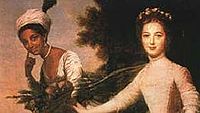
Lady Elizabeth Murray
Encyclopedia

- See Elizabeth Murray (born 1940) for the American artist.
Lady Elizabeth Mary Murray (1760-1 June 1825) was the daughter of David Murray, 2nd Earl of Mansfield
David Murray, 2nd Earl of Mansfield
David Murray, 2nd Earl of Mansfield KT, PC , known from 1748 to 1793 as The Viscount Stormont, was a British politician. He succeeded to both the Mansfield and Stormont lines of the Murray family, inheriting two titles and two fortunes.-Life:Mansfield was the son of David Murray, 6th Viscount of...
. On her mother's death in 1766, she was brought up at Kenwood House
Kenwood House
Kenwood House is a former stately home, in Hampstead, London, on the northern boundary of Hampstead Heath. It is managed by English Heritage.-History:...
by her father's brother William Murray, 1st Earl of Mansfield
William Murray, 1st Earl of Mansfield
William Murray, 1st Earl of Mansfield, SL, PC was a British barrister, politician and judge noted for his reform of English law. Born to Scottish nobility, he was educated in Perth, Scotland before moving to London at the age of 13 to take up a place at Westminster School...
.
She married George Finch-Hatton (1747 - 17 February 1823) on 10 December 1785. They had 3 children - Louisa Anne Hatton (d. 1 March 1875), George William Finch-Hatton
George Finch-Hatton, 10th Earl of Winchilsea
George William Finch-Hatton, 10th Earl of Winchilsea, 5th Earl of Nottingham , politician.Hatton, born at Kirby Hall, Northamptonshire, on 19 May 1791, was grandson of Edward Finch-Hatton, and son of George Finch-Hatton of Eastwell Park, near Ashford, Kent, M.P...
(19 May 1791 - 8 January 1858), and Reverend Daniel Heneage Finch-Hatton (1795 - Jan 1866). Coincidentally, George Finch-Hatton's father Edward and the 1st Earl of Mansfield's wife Elizabeth were both children of Daniel Finch, 7th Earl of Winchilsea and Anne Hatton.
In popular culture
- Let Justice Be Done Mixed Blessings Theatre Group. 2008 play featuring the possible influence that Elizabeth Lindsay's cousin Dido Elizabeth Belle might have had on the Somerset Ruling of 1772.

